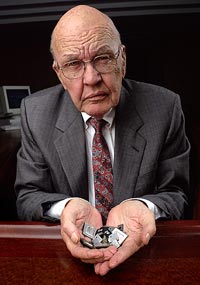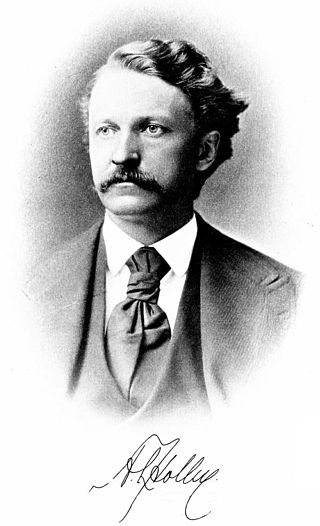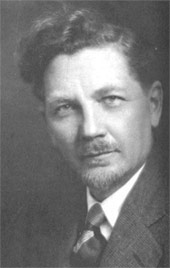Related Research Articles

Jack St. Clair Kilby was an American electrical engineer who took part, along with Robert Noyce of Fairchild Semiconductor, in the realization of the first integrated circuit while working at Texas Instruments (TI) in 1958. He was awarded the Nobel Prize in Physics on 10 December 2000.
The Henry Laurence Gantt Medal was established in 1929 by the American Management Association and the Management section of the American Society of Mechanical Engineers for "distinguished achievement in management and service to the community" in honour of Henry Laurence Gantt. By the year 1984 in total 45 medals had been awarded.

The American Society of Mechanical Engineers (ASME) is an American professional association that, in its own words, "promotes the art, science, and practice of multidisciplinary engineering and allied sciences around the globe" via "continuing education, training and professional development, codes and standards, research, conferences and publications, government relations, and other forms of outreach." ASME is thus an engineering society, a standards organization, a research and development organization, an advocacy organization, a provider of training and education, and a nonprofit organization. Founded as an engineering society focused on mechanical engineering in North America, ASME is today multidisciplinary and global.

Alexander Lyman Holley was an American mechanical engineer, inventor, and founding member of the American Society of Mechanical Engineers (ASME). He was considered the foremost steel and plant engineer and designer of his time, especially in regard to applying research to modern steel manufacturing processes.

The Perkin Medal is an award given annually by the Society of Chemical Industry to a scientist residing in America for an "innovation in applied chemistry resulting in outstanding commercial development." It is considered the highest honor given in the US chemical industry.

The Timoshenko Medal is an award given annually by the American Society of Mechanical Engineers (ASME) to an individual "in recognition of distinguished contributions to the field of applied mechanics."
The American Institute of Mining, Metallurgical, and Petroleum Engineers (AIME) is a professional association for mining and metallurgy, with over 145,000 members. The association was founded in 1871 by 22 mining engineers in Wilkes-Barre, Pennsylvania, and was one of the first national engineering societies in the country.
Jacob Pieter Den Hartog was a Dutch-American mechanical engineer and Professor of Mechanical Engineering at MIT.
The Washington Award is an American engineering award.
The Max Jakob Memorial Award recognizes an 'eminent scholarly achievement and distinguished leadership' in the field of heat transfer. Awarded annually to a scholar by the American Society of Mechanical Engineers (ASME) and the American Institute of Chemical Engineers (AIChE), it is the highest honor in the field of heat transfer these professional organizations bestow.
The Hoover Medal is an American engineering prize.
The American Society of Mechanical Engineers (ASME) established The Edwin F. Church Medal in 1972. Every year it is awarded to "an individual who has rendered eminent service in increasing the value, importance and attractiveness of mechanical engineering education." The ASME intends the Medal to represent Education in a very broad sense: This includes any aspect of mechanical engineering communicate via universities, technical institutes, professional society educational activities, continuing education programs of professional societies and private groups, in-house professional development programs of industrial concerns and governmental agencies, programmed learning and self-instruction systems. This means the nominees need not be professional educators.
The ASME Medal, created in 1920, is the highest award bestowed by the ASME Board of Governors for "eminently distinguished engineering achievement". The award has been presented every year since 1996, and it consists of a $15,000 honorarium, a certificate, a travel supplement not to exceed $750, and a gold medal inscribed with the words, "What is not yet, may be".
The George Westinghouse Medal is named for George Westinghouse and awarded to in honor of "eminent achievement or distinguished service in the power field of mechanical engineering" by the American Society of Mechanical Engineers. There is a Gold medal and a Silver medal. The silver medal may only be awarded to someone under 45 years of age.
The John Fritz Medal has been awarded annually since 1902 by the American Association of Engineering Societies (AAES) for "outstanding scientific or industrial achievements". The medal was created for the 80th birthday of John Fritz, who lived between 1822 and 1913. When AAES was dissolved in 2020, the administration of the Fritz medal was transferred to the American Institute of Mining, Metallurgical, and Petroleum Engineers (AIME), and is currently coordinated by AIME member society, the Society of Mining, Metallurgy, & Exploration (SME).
Hjalmar Gotfried Carlson was an American sheet metal worker, expert in metal drawing, superintendent, and inventor, who worked in Worcester, Massachusetts. He is known for being awarded the first ASME Medal in 1921, and the first Holley Medal in 1924.
Ervin George Bailey was an American mechanical engineer, founding president of Bailey Meter Company, manufacturer of industrial meters and controls, and inventor. He was recipient of the 1942 ASME Medal, and served as 67th president of the American Society of Mechanical Engineers.
Edwin Burnley Powell was an American mechanical and consulting engineer. He was awarded the 1954 ASME Medal for many years of consulting engineer. The ASME had argued, that in these days he was "probably the most widely consulted engineer in the public-utility field."
Llewellyn Michael Kraus Boelter was an American engineer, Professor of Mechanical Engineering at the University of California, Los Angeles, and founding Dean of its UCLA Henry Samueli School of Engineering and Applied Science.
Elmer Otto Bergman was an American civil, mechanical and consulting engineer at the University of Colorado and at C. F. Braun & Company, later KBR Inc. He served as the 83rd president of the American Society of Mechanical Engineers in the year 1964–65.
References
- 1 2 Holley Medal - ASME at asme.org. Accessed 08-05-2017
- ↑ Technology Review, Vol. 32, 1930, p. 208
- ↑ Electrical World, Vol. 126, 1946, p. 69
- ↑ Power Engineering, Vol. 56, 1952. p. 107
- ↑ Mechanical Engineering, Vol. 77, 1955, p. 558
- ↑ Mechanical Engineering, Vol. 96, 1974. p. 87
- ↑ Mechanical Engineering, Vol. 97, 1975, p. 83
- ↑ Mechanical Engineering: The Journal of the American Society of Mechanical Engineers. The Society, 1980. p. 149